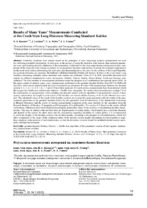| dc.contributor.author | Kosarev, N. S. | |
| dc.contributor.author | Lechner, J. | |
| dc.contributor.author | Padve, V. A. | |
| dc.contributor.author | Umnov, I. A. | |
| dc.coverage.spatial | Минск | ru |
| dc.date.accessioned | 2023-02-08T10:49:52Z | |
| dc.date.available | 2023-02-08T10:49:52Z | |
| dc.date.issued | 2023 | |
| dc.identifier.citation | Results of Many Years’ Measurements Conducted at the Czech State Long Distances Measuring Standard Koštice = Результаты многолетних измерений на линейном базисе Коштице / N. S. Kosarev [et al.] // Наука и техника. – 2023. – № 1. – С. 13-19. | ru |
| dc.identifier.uri | https://rep.bntu.by/handle/data/126101 | |
| dc.description.abstract | Currently, electronic total stations based on the principles of laser long-range distance measurement are used for collecting geospatial information. As time goes, in the process of using the electronic total stations, their technical parameters vary, necessitating periodic calibration of the instruments. Calibration of the long-range distance measurement laser component of the electronic total stations is carried out at specialized baselines and consists in testing the constant component of an electronic total station, determining the scale error and determining the cyclic error. In the territory of the Czech Republic, two geodetic baselines are operated, the National Calibration Baseline Hvězda and Koštice. Koštice is the Czech State Long Distances Measuring Standard, where electronic total stations are calibrated. From 2017 to 2020, about 600 electronic total stations by different manufacturers Leica Geosystems, Trimble, Topcon, Sokkia, Nikon, Pentax, South and Geomax were calibrated. The total number of measurements performed under the program in all combinations has equaled about 40000. In this paper, results of analysis many years’ measurements performed at the geodetic baseline Koštice from 2017 to 2020 with electronic total stations manufactured by Leica Geosystems are presented. In total, 9186 measurements between the baseline sections 1–2, 1–3, 1–4, 1–5, 1–6, 1–7 and 1–8 have been analyzed. For each section, measurements have been detected which did not pass the Grubbs test criterion (the Smirnov – Grubbs test). Altogether, 261 outliers have been detected, totaling 3 % of the total number of measurements. After excluding the detected outliers with the algorithm of the parametric version of least squares optimization, the length of each section of the baseline was found, and the accuracy of the results obtained was evaluted. The calculated values of the length of the baseline sections are in generally good agreement with the results of the measurements performed at the geodetic baseline Koštice by the specialists from the laboratory of the Bundeswehr University in Munich (Germany) and the results of similar measurements conducted at the same baseline by the specialists from the Research Institute of Geodesy, Topography and Cartography (Czech Republic). For section 1–5, based on the results of both verifications, differences have been obtained exceeding the permissible values of the accuracy of determining baseline characteristics. This may be related to the fact that there are displacements of certain pillars, which mainly have a periodic character and depend on the season. To allow more specific assumptions regarding instability of certain pillars, it is recommended to verify the lengths of the baseline sections once in three months, according to the program in all combinations, which will allow comparison of the values of the confidence limits of the baseline section lengths and putting forward hypotheses regarding variations in the position of individual centers, so that the deviations revealed should be included into the residual uncertainty of length measurement. | ru |
| dc.language.iso | en | ru |
| dc.publisher | БНТУ | ru |
| dc.title | Results of Many Years’ Measurements Conducted at the Czech State Long Distances Measuring Standard Koštice | ru |
| dc.title.alternative | Результаты многолетних измерений на линейном базисе Коштице | ru |
| dc.type | Article | ru |
| dc.identifier.doi | 10.21122/2227-1031-2023-22-1-13-19 | |
| local.description.annotation | В настоящее время для сбора геопространственной информации широко используются электронные тахеометры, основанные на принципах лазерной дальнометрии. В процессе эксплуатации изменяются их технические параметры и возникает необходимость периодической калибровки. Она осуществляется на специальных линейных базисах и состоит в поверке постоянной cоставляющей электронного тахеометра, определении ошибки масштаба и циклической ошибки. На территории Чешской Республики действуют два линейных базиса – Гвезда и Коштице. Последний является национальным государственным эталоном длины дальних расстояний, на котором осуществляются поверки электронных тахеометров. С 2017 по 2020 год здесь выполнена калибровка порядка 600 тахеометров различных фирм (Leica Geosystems, Trimble, Topcon, Sokkia, Nikon, Pentax, South и Geomax), общее количество измерений во всех комбинациях около 40000. В статье представлены результаты анализа многолетних измерений, проведенных на линейном базисе Коштице тахеометрами фирмы Leica Geosystems. Исследованы 9186 измерений между секциями базиса 1–2, 1–3, 1–4, 1–5, 1–6, 1–7 и 1–8. По каждой секции выявлялись измерения, которые не прошли заданный критерий Смирнова – Граббса, обнаружен 261 выброс, что составляет 3 % всех измерений. После исключения выбросов с помощью алгоритма параметрической версии МНК-оптимизации определена длина каждой секции базиса и выполнена оценка точности полученных результатов. Вычисленные значения длин секций в целом хорошо согласуются с результатами измерений, проведенных на линейном базисе Коштице Лабораторией геодезии Военного университета Мюнхена (Германия) и Научно-исследовательского института геодезии, топографии и картографии. По секции 1–5 в ходе обоих сравнений получены разности, превышающие допустимые значения точности определения характеристик базиса. Это может быть связано с тем, что по отдельным пунктам наблюдаются смещения, которые носят в основном периодический характер и зависят от времени года. Для более конкретных предположений о нестабильности отдельных пунктов рекомендуется проводить поверку длин секций базиса один раз в три месяца по программе во всех комбинациях, что позволит сопоставлять значения доверительных границ длин секций базиса и выдвигать гипотезы о колебаниях положения отдельных центров. В дальнейшем это позволит включать полученные смещения в остаточную неопределенность измерения длины. | ru |

